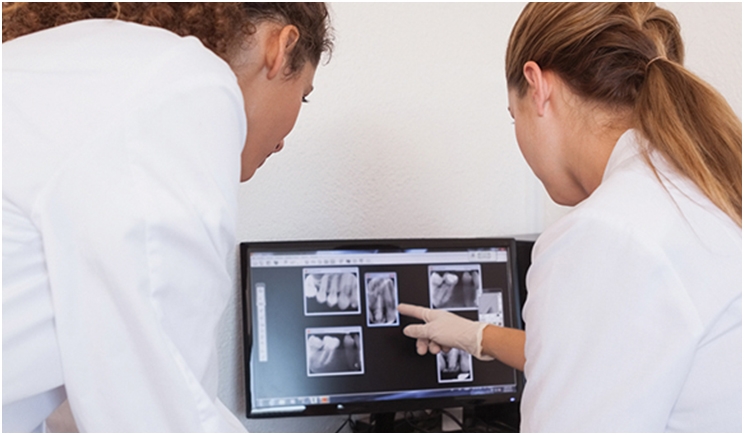
Your dental office just purchased new practice management software. Like any new investment, you’re excited about the potential! This software is going to transform your approach to patient care and support the practice in so many ways, you think.
The first step is to get your team trained on the new software. Once initial training has been completed, you start using it in your day-to-day processes and routines. Things are going well. The team understands the basic functionality and is using it as they have been taught.
But then you start hearing about updates. Is there something you don’t know about—a new feature or function that would further improve day-to-day operations within your practice? You worry you may not be getting everything you need—or want—from the software. You hire a new employee and he’s not familiar with it. You even start wondering if you’re really providing the best patient care you can with the software.
This is a common scenario playing out in thousands of dental offices across the country each year. Dentists are purchasing new practice management software with the best of intentions to be more efficient and productive and to deliver better patient care.
But more often than not, after that initial purchase, and wave of energy and enthusiasm, dental offices aren’t keeping their teams continuously trained on the software. And they are missing out on substantial opportunities for improved efficiencies and better patient care.
Offering continuous training to dental office teams on practice management software has big advantages. Among them:
- It ensures awareness and understanding of software enhancements: Software manufacturers unveil new software enhancements all the time—at the very least, on an annual basis. To get the most out of the software and subsequent enhancements, your team must be aware of those updates and enhancements. For example, if you’re an Eaglesoft user, you’ll want your team to be trained on its newest feature called SmartNotes, which helps keep teams standardized and consistent in their note creation.
- Fully utilizing all features of the software: Teams often don’t have the time to learn about all the features their practice management software offers during the initial training. They start working with the new software without understanding everything it is capable of doing. Additionally, team members may not retain a large percentage of what they learned during the initial trainings. In fact, research by the National Training Laboratory (World Bank, n.d.) shows that the amount of new information that learners retain depends on how the information is presented and accepted. Retention rates for adults range from 5% to 90% of what they’re actually taught. (REF: World Bank (n.d.) The Learning Pyramid). This means that some of our team members are potentially working with just a small portion of the software’s capabilities. Continuous training ensures team members dive into the newer features and learn more about all of the software’s capabilities.
- It streamlines on-boarding for new employees who need to get smart about the software: If there’s one constant with any dental office, it’s turnover. It’s inevitable. So when on-boarding new team members, they are often learning the ins and outs of the practice management software on their own or from other team members. That’s not an ideal situation. By offering continuous training, new team members have the opportunity to learn from the same experts as the rest of the office, allowing them to best utilize the software.
The Benefits
There are financial benefits to continuous training on practice management software as well. More frequent training and encouragement positions team members to use all of the features of the software, and it increases the odds they’ll become more productive. More productivity leads to greater efficiency, which is better for the bottom line.
What about the impact on patient care? Improved efficiency gained from maximizing the software’s potential allows more time to focus on patients and their treatment. This means more time to bring the value of the software to bear.
When done well, ongoing training also always includes an agenda with clear expectations of what the office wants to achieve. In the morning of a typical training day, a trainer is on-site observing teams with patients, how they are using the software, and what functionality is being missed. In the afternoon, the trainer uses what they learned to showcase how team members can take full advantage of the tools they’re not currently using (without patients present). The key is blocking off an entire afternoon to devote to learning. Believe me, it’s worth it in the long run.
Ideally, training should take place at least once every six months. After the initial training on new software, you should typically follow-up one to two months after and then every six months moving forward. Again, the goal is to keep your team updated on software enhancements, showcase more advanced features, and train new team members to maximize value.
One last thought: Yes, continuous training on practice management software is an investment. But it’s an investment that can return big results when it comes to team efficiencies, productivity, and patient care. In fact, over the course of a year, you can see productivity increase substantially, and team members using their time more efficiently and effectively with your patients, developing the best possible patient experience your practice can offer.
Ms. Horvath is a Corporate National Technology Advisor with Patterson Dental. She has more than 44 years of experience in the dental industry, including the last 19 with Patterson in a variety of roles such as Regional Training Advisor and Regional Technology Manager.
Related Articles
How to Switch Software Systems as Painlessly as Possible
Fuse: Practice Management for an Evolving Industry











